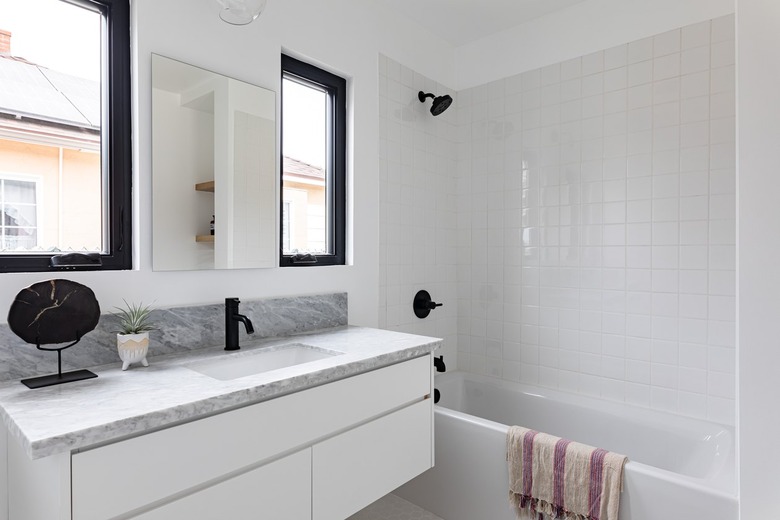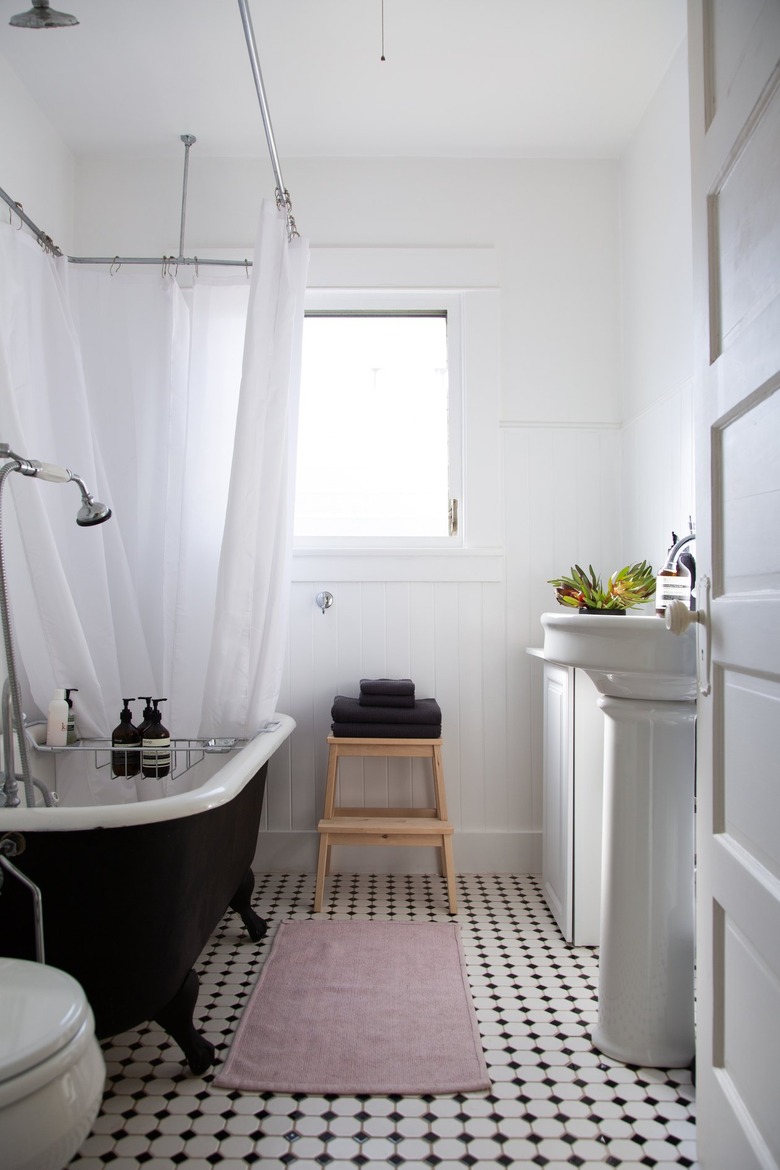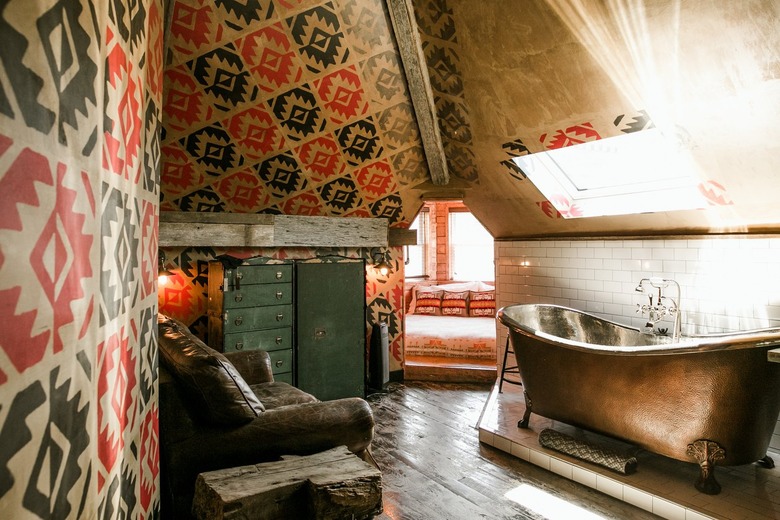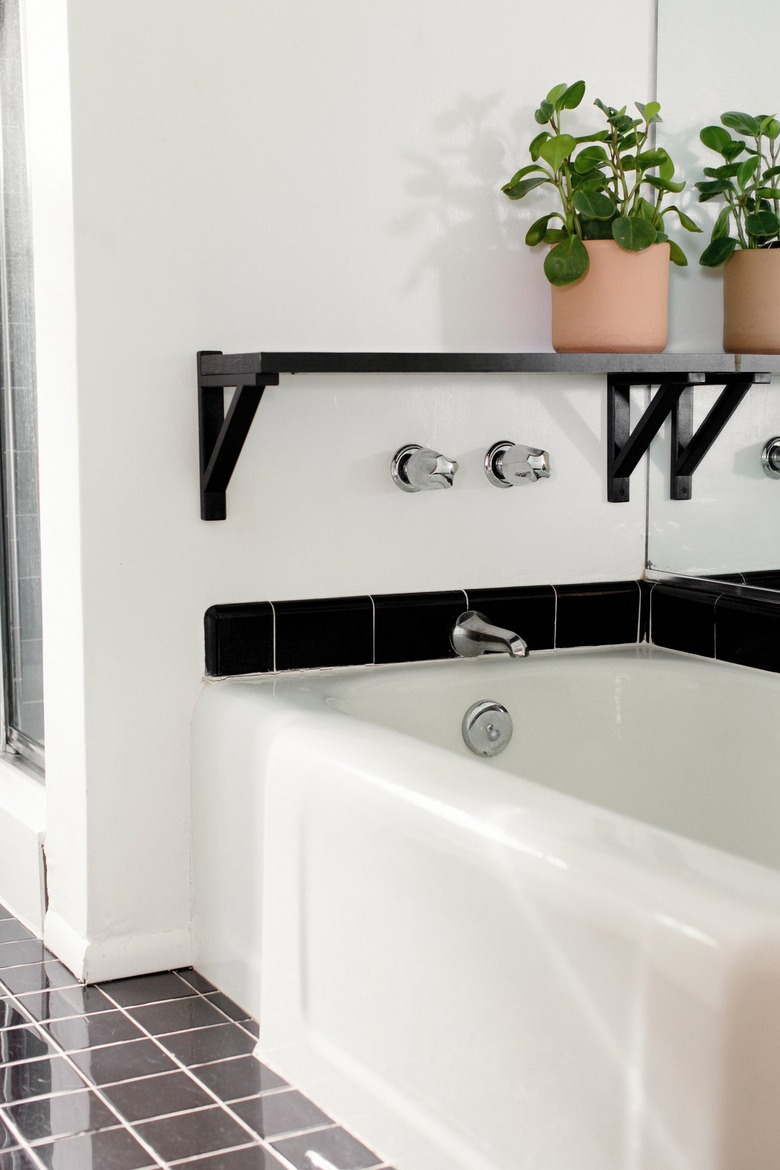Buying, Installing And Maintaining Bathtubs: A DIY Guide
When it comes to bathroom fixtures such as toilets and toilet seats, the Japanese have the rest of the world outclassed, and the same is true for bathtubs. All you have to do is take a soak in a one-person-size ofuro with your body completely immersed in soothing hot water to realize that. Unfortunately, ofuros are rare in North America, and even if you can find one, you'll have to pay a premium price to put one in your bathroom.
Standard bathtubs in North America are rectangular with an inside length of 60 inches, a width of 32 inches and a depth of 14 to 17 inches, which is enough water-filled space for children to immerse themselves but not adults. There's no reason to settle for a standard bathtub, however, because you have a wide choice of sizes, materials and shapes to fit any bathroom. Few are as minimalistic and satisfying as an ofuro, but many come close, although most use more water than a Japanese soaking tub. If you're on the lookout for a new bathtub as part of a home improvement project, you should know what's involved with installation, care and maintenance of the many models out there.
Classify Bathtubs by Experience and Installation
Classify Bathtubs by Experience and Installation
Shopping for a new bathtub can be a dizzying exercise because of the plethora of models you can find, and to allay the confusion, Compact Appliance suggests thinking in two broad categories. The first is the experience you want from a bathtub, whether it be an hour-long soak, an occasional bubble bath or simply your daily shower. You can often get a preview of how a tub feels by going ahead and sitting in one while it's still on the showroom floor. Factors that help determine the experience you'll have in a tub include:
- Shape and size of the bathtub
- Bathtub material and design
- Features, such as whirlpool jets
The second is the installation, which includes the size and shape of the available space, the solidity of the subfloor and the overall design into which you want the bathtub to fit. When considering installation particulars, you'll want to take into account:
- The number of walls surrounding the tub
- The maximum weight the floor can support
- The design motif into which you want the bathtub to fit
These two categories overlap, and people for whom experience trumps installation may not mind making structural changes to accommodate the bathtub of their dreams. On the other hand, people who want a tub to fit into an existing space will have fewer choices, and their selection will be further limited if they need an ADA-compliant tub for a user with disabilities.
Freestanding Bathtubs, Alcove Tubs and More
Freestanding Bathtubs, Alcove Tubs and More
When you think about it, a bathtub is just a vessel that holds water, and while it can be any shape you want if you have the budget for a custom tub, the ones on the market are mostly oval or rectangular in shape. Most tubs sit next to one or more walls, but some can sit almost anywhere.
- A freestanding bathtub is one that be anywhere in the bathroom (or any other room), and it can have feet, like a vintage clawfoot bathtub, or can rest on the floor, like a single- or double-slipper tub reminiscent of the washbasins of times gone by. It can also be sunken into the floor and can rest on a support structure underneath it. Because it isn't next to a wall, the plumbing pipes have to come through the floor, and that can be part of the charm, especially if the design includes an ornate tub filler faucet and hand shower.
- An alcove bathtub is designed to fit inside a three-wall enclosure that must be constructed to fit. Considered the standard type of bathtub, alcove tubs usually double as shower stalls.
- A drop-in bathtub, like a drop-in sink, mounts in an enclosure built onto a wall and has a rim that rests on the sides of the enclosure to support it. This arrangement provides plenty of design flexibility because the sides of the enclosure can be finished in any material that suits the decor of the bathroom. An ofuro is basically a specialized version of a drop-in tub.
- An undermount bathtub also requires an enclosure attached to a wall, but its rim is secured underneath the enclosure opening, so the tub must be supported from below. This design makes the most of enclosures finished with granite, marble or high-quality solid surface materials.
- A corner bathtub, as the name implies, fits into a corner. It comes with its own enclosure, which can have one straight exposed side, a curved one or three or more sides that form part of a polygon. The bathing area can match the shape of the enclosure, or it can be rectangular, oval or some other shape.
- A walk-in bathtub has a door in its front panel that opens to allow easy access and closes to form a watertight seal. Walk-in bathtubs are intended for use by anyone who has a hard time climbing into the tub.
Common and Uncommon Bathtub Materials
Common and Uncommon Bathtub Materials
The standard alcove bathtub is usually made from fiberglass or acrylic, with acrylic being the preferred material because of its added durability. These materials are inexpensive and lightweight, but they're easy to scuff, the color fades with time and they are flexible, so they can crack. Older enameled cast iron alcove bathtubs are still around, but because their weight requires extra support, they aren't as common in new construction or remodels as they used to be.
When it comes to freestanding, drop-in and undermount bathtubs, more heavy-duty materials are more common because flexible materials need the wall support of an alcove. Popular materials are cast iron, porcelain, wood, stainless steel, solid surface polymer and, on the elegant-but-pricey side, glass and copper. Acrylic freestanding tubs are also available on the low end of the price scale.
Heavy materials, such as cast iron, porcelain and wood, are best for a soaker tub because they retain heat well, but because of their weight, they may require extra support. Solid surface polymer resin also retains heat well, and because it's relatively lightweight and attractive, it's a sensible choice, especially for undermount and drop-in tubs.
What's Involved With Installing Bathtubs?
What's Involved With Installing Bathtubs?
A bathtub needs a level surface on which to rest, and the floor framing must be strong enough to support its weight along with that of all the water it holds and the weight of the person using it. The builder preparing the floor for the tub may have to add extra support framing and install a new 3/4- or 1-inch subfloor to support the new tub, although acrylic and fiberglass alcove tubs are so lightweight that they can usually rest on the existing floor joists and subfloor. Freestanding tubs usually require additional support, and in the case of a partially recessed one, a dedicated support structure has to be built.
Installing the drain and water supply pipes is straightforward when the tub is next to a wall because the pipes can be installed in the wall or under the floor and covered. The orientation of the tub may be an issue if it has to be connected to existing pipes, but you can usually avoid problems by choosing one with a center drain, a left-hand drain or a right-hand drain as needed. Bathtub faucets can also be installed on a wall and centered over the drain opening.
The fact that the plumbing pipes have to come through the floor to service a freestanding bathtub can present problems, especially on a ground floor with no access underneath. A concrete slab on the ground floor is actually an ideal setting for a freestanding tub, but if you're planning to do this, it's advisable to rough in the plumbing for the tub before you pour the slab. When you have access underneath the floor, installing the drain and water supply pipes is a less expensive job for a plumber than installing pipes in the walls, and a plumber can also obtain the permit you'll need from the local building department.
The Cost of Installing a New Bathtub
The Cost of Installing a New Bathtub
Bathtubs range widely in price. You can purchase a standard fiberglass alcove bathtub for less than $200, but if you're looking for a more durable model with a bit more style, such as a Kohler Underscore or an American Standard Cambridge, expect to pay more than three times that amount. Prices for freestanding and other types of specialty soaking tubs start at around $900, and you can pay as much as $3,000 for some models, such as a Winifred resin slipper tub.
Installation costs are generally higher for alcove tubs than freestanding ones because more work is involved in the preparation. According to Fixr, the average cost for a new acrylic alcove tub with installation is $1,350, but a similar freestanding tub costs only $1,200 installed. The installation costs alone are $1,000 for an alcove tub and $350 for a freestanding one. Drop-in and undermount tubs generally cost more than either of these types, and because they require the construction of a tub enclosure, the installation costs are higher as well.
Care and Maintenance of Bathtubs
Care and Maintenance of Bathtubs
Although cleaning methods vary with bathtub material, the use of abrasive cleaners is hardly ever a good idea. The National Association of Realtors recommends a mixture of dish soap and warm water for virtually all bathtub materials, including fiberglass, acrylic, solid surface polymers, enameled cast iron and porcelain. If you need to add a cleaning powder to remove stubborn stains, use baking soda instead of scouring powder or anything similarly harsh that will scratch and dull the finish.
When hard water or iron stains develop, you can usually remove them with a paste made from vinegar and a nonreactive powder, such as borax or laundry detergent. Cover the stains with the paste and give it several hours to work before washing it away. Then, use a toothbrush to scrub off any residual discoloration. Vinegar may dull the finish, but you can usually restore the shine by rubbing a little car wax on the surface and buffing it up with a soft cloth.
When cleaning or disinfecting a bathtub, don't just do part of it — clean the entire surface. Even though mold can't grow on bathtub surfaces, it can grow in the drain and along the edges of the tub that meet the wall. The best way to remove mold is not to douse it with bleach, which can dull the finish, but to scrub it thoroughly with soap and water until no mold discoloration remains. Never clean stainless steel with bleach because it can cause permanent staining and pitting.



